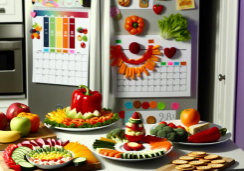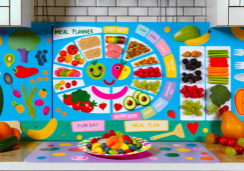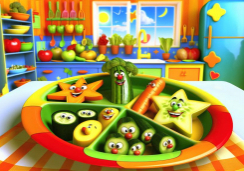Streamlined Meal Planning: 14 Tips for Busy Moms
Just as you've finally cleared the breakfast dishes and sit down for a moment of peace, you're hit with the dreaded question, 'What's for dinner?'
As a busy mom, you're all too familiar with the daily hustle and the added pressure of providing nutritious, home-cooked meals. You might think you don't have the time to plan, but what if you could organize your meals like a pro, saving precious minutes and your sanity?
By adopting a few smart strategies, you can streamline your meal planning process and transform what once was a chaotic scramble into a manageable part of your day. Let's explore together how you can simplify your approach to meal planning with practical tips that cater to your hectic schedule, keep your family's tastes in mind, and perhaps even create space for a bit of well-deserved 'you time.'
Start Small With Planning
Embarking on meal planning doesn't have to be overwhelming; begin by introducing themed nights or choosing just one meal to plan for the upcoming week, particularly targeting your busiest days to alleviate stress. This method eases you into the habit without the pressure of revamping your entire culinary schedule at once. It's about starting small and gradually building a routine that's sustainable.
When you start meal planning, use a meal planning template to organize your thoughts and grocery lists. A template serves as a visual aid that simplifies decision-making and ensures a nutrient-rich, balanced diet. By planning meals in advance, you're less likely to resort to takeout on hectic nights, thus nurturing healthier eating habits for you and your family.
Share the responsibility with a partner to make meal planning a team effort, which can make it a more manageable and enjoyable task. Allocate a dedicated time to plan, perhaps during a weekend reset. This time-blocking technique ensures you have a clear schedule to focus on your meal plan chart, making simple meal planning a reality rather than an aspiration.
With these strategies, you'll find that a little time invested in planning can yield a week full of stress-free, healthful eating.
Schedule Your Planning Time
Setting aside a specific time each week for meal planning can significantly streamline your meal preparation and ensure you're providing balanced, nutritious meals for your family. By dedicating one night a week to schedule your planning time, you can approach this task with focus and efficiency. This consistent time each week allows you to craft a weekly meal plan that caters to your family's health needs and preferences.
During this scheduled time, use time-blocking techniques to focus solely on meal planning. Turn it into a self-care session if that makes the experience more enjoyable for you. Remember, the initial planning may take a bit longer, but as you make it a regular habit, perhaps during your weekend reset, you'll find the process becomes simpler and quicker.
Don't forget to Create a Shopping List that corresponds with your weekly meal plan. This ensures you'll have all the necessary ingredients on hand, which saves time and reduces stress throughout the week. Additionally, keeping a visible meal plan chart or using tools like magnetic meal plan tear pads can provide easy reference and help keep you on track.
With a little organization and a set schedule, you'll master the art of meal planning in no time.
Keep a Meal Journal
Maintaining a meal journal allows you to track the success of each dish you serve, helping you refine your meal plans for maximum nutritional benefit and family satisfaction. As a busy mom, you're constantly seeking ways to save time, and a meal journal can be your secret weapon.
By recording what meals work and those that don't, you can create a repertoire of family favorites that streamline your meal planning process.
In your meal journal, note any adjustments you've made to the recipes. Was there a dish that was particularly well-received when you swapped in quinoa for rice? Did adding extra veggies to a casserole make it more filling and nutritious? These small changes can lead to big improvements in your family's diet and can be easily overlooked without proper tracking.
Also, use your journal to document any new recipes you've tried. This will help you remember which ones to revisit and which to set aside. Reflect on the challenges you've faced, such as finding the right balance of flavors or managing prep time.
Your meal journal is more than a record; it's a tool that evolves with your family's tastes and your growing expertise in meal planning.
Align Meals With Schedules
As you assess your weekly commitments, plan for quick prep dinners on your busiest nights to maintain a nutritious diet without the stress.
Batch cooking strategies can save you time and ensure you have healthy options on hand when schedules are tight.
Assess Weekly Commitments
To effectively manage your week, regularly evaluate your family's commitments and align your meal planning with the busiest days to ensure time constraints don't disrupt healthy eating. For your busy family, this strategy helps in creating a weekly menu that's both practical and nutritionally balanced.
When you're aware of the week's demands, you can save time and effort by preparing simpler meals on hectic evenings, or even cooking in advance. Make sure your grocery list reflects the needs of these meals, so you're not caught off guard.
Involve your family in this process, allowing their schedules to influence the meal planning, ensuring everyone's needs are met. Remember, flexibility is key. Be ready to tweak your plans for unexpected changes, keeping mealtime stress-free and nutritious.
Quick Prep Dinner Nights
Building on the strategy of aligning meals with your family's weekly commitments, incorporating quick prep dinner nights can be a lifesaver on your most hectic evenings. When you're balancing work, school runs, and extracurricular activities, here's how to ensure everyone still enjoys a nutritious dinner:
- Opt for One-Pot Wonders: Select recipes that require minimal prep and cook everything in one pot or a slow cooker. This not only saves time but also simplifies cleanup.
- Prepare Meals Ahead: Utilize a free afternoon to make-ahead meals that you can freeze and then quickly reheat. Think lasagna, soups, and casseroles.
- Grab and Go Options: Stock up on healthy 'grab and go' items for those evenings when even quick and easy meals seem too much. Pre-cut veggies, rotisserie chickens, and pre-cooked grains are perfect for throwing together a balanced meal in minutes.
Batch Cooking Strategies
Harnessing the power of batch cooking can align your meal preparation with the ebb and flow of your weekly schedule, ensuring that time constraints don't compromise the nutritional value of your family's meals. By setting aside time on a less hectic day, you can cook large batches of nutritious dishes that can be easily stored in airtight containers.
This strategy not only saves time during busier days but also reduces stress. When your schedule ramps up, you'll be thankful for these pre-prepared meals that can quickly be reheated. Adapting your meal plan to unforeseen events becomes simpler with batch cooking strategies.
Always be ready to adjust, and remember, the freezer is your ally for those extra busy days or unexpected changes. Keep balance and nutrition in mind as you plan, cook, and store your family's meals.
Build a Recipe Arsenal
Amassing a diverse collection of recipes can streamline your meal planning process, ensuring you've got a dish for every dietary need and time constraint in your household. Building a recipe arsenal isn't just about having a variety of meal ideas at your fingertips; it's about creating a meal strategy that works for you and your family.
Here are three key steps to get you started:
- Experiment with Variety: Don't shy away from trying new recipes. This expands your cooking repertoire and prevents mealtime monotony. Ensure that you include options that cater to any dietary restrictions in your family.
- Masterlist for Quick Reference: Whether it's a digital document or a physical binder, create a masterlist of go-to meals. This should be your quick reference guide when you need recipes to plan meals effectively.
- Focus on Nutrient-Dense Options: Your recipe arsenal should be nutrient-focused. Strive for balance by incorporating a mix of proteins, grains, and fresh produce. Look for recipes that provide a good balance of vitamins and minerals to support a healthy diet.
Embrace Cooking Shortcuts
While you expand your recipe collection, it's equally important to embrace cooking shortcuts that can trim time off meal preparation without sacrificing nutrition. With your busy schedule in mind, quick recipes with minimal prep steps are your best friends. They allow you to whip up wholesome meals without spending hours in the kitchen.
For efficient meal prep, consider batch cooking. This method lets you prepare multiple meals at once, using versatile ingredients that can be mixed and matched throughout the week.
Invest in essential tools like quality food storage containers and sharp knives to speed up the chopping and storing process. Furthermore, a meal planning app or notebook keeps you organized and on track.
For breakfast, freezer-friendly options such as protein-packed egg muffins or make-ahead pancake mix can be lifesavers on hectic mornings. Don't forget time-saving hacks like utilizing your slow cooker for hot breakfasts that are ready when you wake up, or preparing the night before to minimize morning stress.
These cooking shortcuts are designed to fit seamlessly into your routine, making meal prep less of a chore and more of a breeze.
Allow for Flexibility
As a busy mom, it's essential to weave flexibility into your meal planning, allowing for those inevitable times when plans shift or ingredients are unavailable. An adaptable approach won't only save you time but also reduce stress for your busy family.
Here are some strategies to maintain balance and nutrition while keeping meal planning flexible:
- Swap with Ease: If Tuesday's dinner can't happen because you're missing an ingredient, don't fret. Have a couple of versatile dishes in your repertoire that you can whip up at a moment's notice. These are meals that use common pantry staples or ingredients that have a longer fridge life.
- Versatile Ingredients: Stock up on items that can be used in multiple dishes. Think of grains, frozen vegetables, and proteins that can be the base for more than one meal. This approach not only simplifies grocery shopping but also ensures that you're ready for last-minute changes.
- Back-Up Meals: Always have a backup plan. Whether it's a simple pasta dish, a quick stir-fry, or a family-favorite casserole, ensure that you have the ingredients for at least one meal that can be prepared without much notice.
Pre-Plan Grocery Shopping
When you pre-plan your grocery shopping, you're setting the stage for nutritional success and fiscal responsibility.
By crafting a strategic list organized by food groups, you can navigate the store efficiently, ensuring you get all the essentials while maintaining a balanced diet.
Stay true to your list to sidestep impulse buys, keeping both your pantry and budget in check.
Strategic List Crafting
Crafting a strategic grocery list tailored to your family's weekly menu can significantly streamline your shopping experience and ensure you don't overlook any essential items. When you're Shopping List Based, you're organized and ensure that:
- You're only buying what you need by checking off ingredients you already have before you head to the grocery store.
- You prioritize your purchases according to meal preparation frequency and your family's nutritional needs.
- You save time and money by aligning your list with store layout and current sales.
This approach not only helps you stay on top of your nutritional game but also minimizes food waste. As you navigate the grocery store aisles, your well-planned list becomes your roadmap to efficient shopping, allowing you to focus on quality ingredients you need to buy.
Efficient Store Navigation
Having crafted your strategic shopping list, your next step is to navigate the grocery store efficiently, ensuring you stick to your meal plan and budget. By categorizing your list according to food groups, you're primed for a more organized shopping experience, saving time as you move through the aisles. Keep your focus on nutrient-dense foods that align with your meal prep goals.
Utilize meal planning apps or notebooks to check off items as you go, maintaining an efficient flow. Watch for sales and discounts; they're opportunities to economize without deviating from your list. However, remain flexible—sometimes a substitute can be just as nutritious and cost-effective.
With this approach, grocery shopping becomes a streamlined task that supports your busy lifestyle and your family's health.
Use Themed Meal Nights
To inject some excitement and structure into your weekly meal planning, consider adopting Themed Meal Nights. These themed nights not only streamline the process but also ensure a diverse and enjoyable menu for the whole family.
As a busy mom, you're often juggling countless tasks, and meal planning can seem daunting. Themed Meal Nights are a strategic way to save time while keeping meals interesting for all family members.
Here are three compelling reasons to embrace themed nights:
- Simplified Decision-Making: By having a theme for each night, you eliminate the daily 'what's for dinner?' dilemma. Taco Tuesday or Pasta Night gives you a starting point, reducing the mental load associated with meal planning.
- Balanced Nutrition: Rotating themes can help you incorporate a variety of food groups and nutrients. For example, Meatless Monday encourages plant-based eating, which can introduce your family to new, healthy ingredients.
- Family Involvement: Involve family members in choosing and preparing meals. This shared activity not only makes mealtime preparations quicker but also encourages healthier eating habits as everyone takes part in the process.
Implementing themed meal nights transforms meal planning from a chore into a creative, collaborative, and health-conscious activity. Give it a try and watch how it revolutionizes your weekly routine.
Batch Cook and Freeze
Batch cooking and freezing meals can revolutionize your weekly meal prep, offering time-saving convenience and ensuring nutrient-rich dinners are always at the ready.
As a busy mom, you understand the struggle of balancing work, family, and healthy eating. By choosing to batch cook and freeze, you're taking steps to maintain a balanced diet for your family while saving precious time.
Start by planning and preparing multiple meals in one go. You can chop ingredients in advance, assemble dishes, and cook in bulk. Once done, portion out the meals and freeze them. This approach not only helps you save time during the week but also reduces food waste and controls portion sizes, which is essential for maintaining a healthy lifestyle.
Involve your family members in the meal prep process. It's a great way to share the workload and teach your kids valuable life skills. Label and date the freezer meals to keep your meal rotation organized and ensure you're consuming the freshest options available.
Remember to vary the types of meals you batch cook and freeze. This prevents meal fatigue and ensures your family receives a diverse array of nutrients.
With these tips, you'll have a freezer stocked with wholesome meals that are ready to heat and serve on your busiest days.
Love Your Leftovers
While batch cooking and freezing set the stage for easy meal times, don't overlook the potential of leftovers to extend your menu and maximize nutrition. Embracing leftovers can significantly streamline your meal planning, save you a lot of time, and contribute to a sustainable household by helping to reduce food waste. Here's how you can make leftovers work for you:
- Reinvent Them: Get creative and transform yesterday's meals into today's new flavorful dishes. Turn roasted vegetables into a hearty omelet filling or blend them into a nutritious soup.
- Plan for Them: When cooking, intentionally make more than you need. This way, you'll have a base for a healthy and delicious meal ready to go. Leftovers can be a lunchtime lifesaver during a busy workweek.
- Store Smartly: Use clear, airtight containers to store leftovers. Label them with the date, and keep an eye on how long they've been in the fridge to ensure they stay fresh and safe to consume.
Get the Family Involved
Involving the entire family in meal planning not only diversifies your weekly menu but also fosters a sense of teamwork and responsibility in the kitchen. Encourage each family member to suggest their favorite meals, which can make meal planning a more inclusive and exciting event. This way, you're more likely to prepare meals for your family that everyone will enjoy, and it allows for a balanced variety of nutrients as different people will crave different types of food.
Training your kids in the kitchen from an early age also builds independence and life skills. They can contribute their own ideas to the planning process and feel a sense of ownership over the meals they help create. Keep a master list of meal ideas and continuously update it with new finds to keep your meal planning fresh and adaptable.
To keep everyone on the same page, use a visible meal plan chart. Tools like magnetic meal plan tear pads or home management binders can be excellent organizational aids. Having a physical or digital chart helps the whole family stay involved and informed about what's on the menu, streamlining the planning process and ensuring that meals are well-thought-out and nutritious.
Organize Your Pantry
After getting your family on board with meal planning, the next step is to ensure your pantry supports your organized approach with easy-to-find ingredients and streamlined storage. As you delve into meal planning for busy schedules, an organized pantry is vital to keep track of what you have and what you need.
Here's how you can organize your pantry effectively:
- Group Similar Items: Keep similar items together. This not only makes it easier for you to see what's in stock at a glance but also helps you retrieve items without hassle during the cooking rush.
- Label and Use Clear Containers: Transfer bulk items into clear containers with labels. This simple step not only preserves the freshness of your ingredients but also allows you to quickly identify what you have, which is crucial for efficient meal planning.
- Regular Decluttering and Inventory: Set aside time each month to declutter and clean your pantry. This practice ensures that you use up what you have, reducing waste and saving money, and it helps you take inventory before you shop to avoid buying duplicates.
What Are Some Tips for Efficient and Streamlined Meal Planning for Busy Moms?
Efficient meal planning for busy moms can be achieved through streamlined meal prep techniques. Utilize batch cooking, plan versatile meals, and involve family members in meal prep to save time. Create a shopping list and schedule dedicated meal prep time to ensure hassle-free cooking during the week.
Reflect and Adapt Weekly
Reflect on the past week's meals to fine-tune your planning, ensuring your family's diet remains diverse and nutritionally balanced. In streamlined meal planning, the key is to evaluate the successes and challenges of your meal plans. As a busy mom, you've got a week to plan, shop, and cook, so it's crucial to assess what dishes were hits and which ones missed the mark. Did an unexpected event throw off your schedule? Adapt your plan to be more flexible.
Each week, take a moment to reflect and adapt weekly. This isn't just about tweaking a recipe here and there; it's about accommodating life's surprises while keeping nutritional quality at the forefront. Were there meals that lacked variety? Introduce new recipes and flavors to keep your family engaged and excited about their meals.
Moreover, consider a visual meal plan chart that's easy to update. This allows you to make quick adjustments when necessary and helps the whole family stay informed about the week's menu. Remember, these tips for busy moms aren't set in stone; they're a guide to help you find a rhythm that works for your unique family dynamic. Stay open and flexible, and your meal planning will become a seamless part of your week.
Frequently Asked Questions
How Do You Meal Prep With a Busy Life?
To meal prep, you'll want to embrace quick batching, streamline with ingredient assembly, focus on freezer stocking, utilize evening chopping, and leverage recipe apps for balanced, nutrient-rich meals despite a hectic schedule.
How Do You Fit Meals Into a Busy Schedule?
You'll fit meals into your busy schedule by picking quick selections, prepping breakfast options in advance, using snack incorporation for energy, choosing simple dinner solutions, and applying grocery hacks for efficient shopping.
What Are 4 Steps to Successful Meal Planning?
To successfully plan meals, you'll need to compile a recipe collection, use grocery apps, consider family preferences, select seasonal ingredients, and practice portion control, ensuring a balanced, nutrient-rich diet for your household.
How Do You Streamline Food Prep?
To streamline food prep, you'll want to master efficient chopping, engage in batch cooking, preassemble ingredients, use smart storage solutions, and choose quick recipes that are nutritious, balanced, and keep your diet on track.
Conclusion
As you embrace these meal planning tips, remember to start small and stay flexible. Dedicate time each week to plan and reflect on what's working.
Keep your pantry organized and your recipe collection growing. Engage your family to share the load and enjoy the journey together.
By doing so, you'll not only save time but also nourish your loved ones with balanced, healthy meals that fit seamlessly into your hectic life.
Keep it up, you're doing great!










